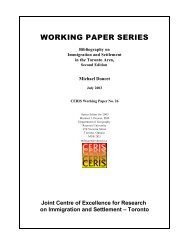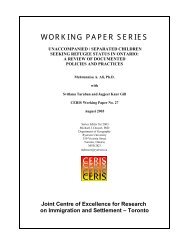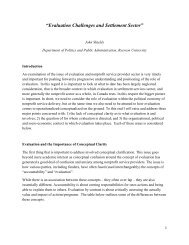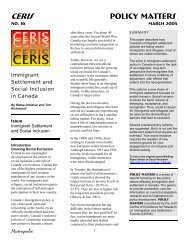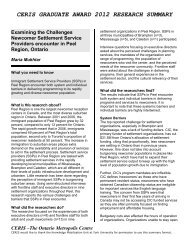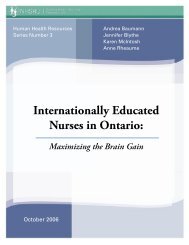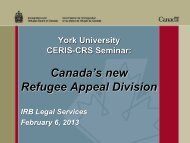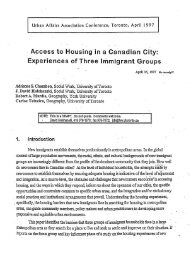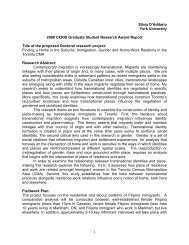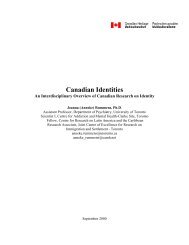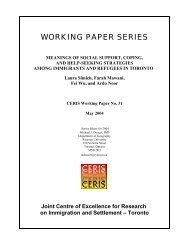Ethno-Racial Inequality in the City of Toronto: An Analysis of the ...
Ethno-Racial Inequality in the City of Toronto: An Analysis of the ...
Ethno-Racial Inequality in the City of Toronto: An Analysis of the ...
Create successful ePaper yourself
Turn your PDF publications into a flip-book with our unique Google optimized e-Paper software.
NON-NATIONAL, “RACIAL” AND MULTIPLE ORIGINSMore than n<strong>in</strong>ety-eight percent <strong>of</strong> “Canadians”, def<strong>in</strong>ed for our purposes as people who said <strong>the</strong>irancestry was Canadian only and were “white”, are born <strong>in</strong> Canada. Also, 69.0 percent <strong>of</strong> <strong>Toronto</strong>nianswho describe <strong>the</strong>mselves as “African” or “Black”, but do not give a fur<strong>the</strong>r national orig<strong>in</strong> are born <strong>in</strong>Canada. To some extent this demonstrates a “racialization” <strong>of</strong> identity as <strong>the</strong> children <strong>of</strong> visible m<strong>in</strong>orityimmigrants are “Canadianized” and start to lose touch with <strong>the</strong>ir parents’ dist<strong>in</strong>ct national identities. Notealso that <strong>the</strong> multiple orig<strong>in</strong> groups <strong>in</strong>clude far fewer immigrants than <strong>the</strong> <strong>in</strong>dividual nationalities. Nearlyone-quarter <strong>of</strong> <strong>the</strong> <strong>Toronto</strong>nians with a s<strong>in</strong>gle British ethnicity are born outside <strong>of</strong> Canada, compared to9.3 percent <strong>of</strong> people with two or more British orig<strong>in</strong>s; about 80 percent <strong>of</strong> people with Arab or WestAsian orig<strong>in</strong> only are immigrants, compared to just 31.5 percent <strong>of</strong> people with Arab or West Asian andEuropean heritage.Ability to Speak EnglishTable 3 gives <strong>the</strong> answers to <strong>the</strong> Census questions deal<strong>in</strong>g with <strong>the</strong> ability to speak English and on <strong>the</strong>language spoken <strong>in</strong> a person’s home. S<strong>in</strong>ce <strong>in</strong>dividuals could <strong>in</strong>dicate that <strong>the</strong>y speak two or morelanguages at home <strong>the</strong> answers we categorized as: only English; English and any o<strong>the</strong>r; French and anyo<strong>the</strong>r language besides English (to avoid overlap with <strong>the</strong> second category); and nei<strong>the</strong>r English norFrench. The asymmetry <strong>in</strong> <strong>the</strong> treatment <strong>of</strong> <strong>the</strong> <strong>of</strong>ficial languages is <strong>in</strong>tended to reflect <strong>the</strong> predom<strong>in</strong>ance<strong>of</strong> English <strong>in</strong> <strong>Toronto</strong>. The s<strong>in</strong>gle question about <strong>the</strong> ability to speak English on <strong>the</strong> Census provides onlya crude division <strong>of</strong> a wide range <strong>of</strong> ability, but it can certa<strong>in</strong>ly be used to locate sizeable concentrations <strong>of</strong>people without m<strong>in</strong>imal skills <strong>in</strong> English.Consider<strong>in</strong>g <strong>the</strong> number <strong>of</strong> immigrants to <strong>Toronto</strong> and especially <strong>the</strong> number <strong>of</strong> recent immigrants,it is noteworthy that only 6.1 percent <strong>of</strong> <strong>the</strong> population say that <strong>the</strong>y do not speak English. The number <strong>of</strong>non-English speakers, about 145,000, is more impos<strong>in</strong>g. While <strong>the</strong>re is considerable variation <strong>in</strong> <strong>the</strong>percentage <strong>of</strong> non-English speakers, <strong>in</strong> every s<strong>in</strong>gle group, <strong>the</strong> great<strong>Ethno</strong>-<strong>Racial</strong> <strong>Inequality</strong> <strong>in</strong> <strong>Toronto</strong>: <strong>An</strong>alysis <strong>of</strong> <strong>the</strong> 1996 Census 27



